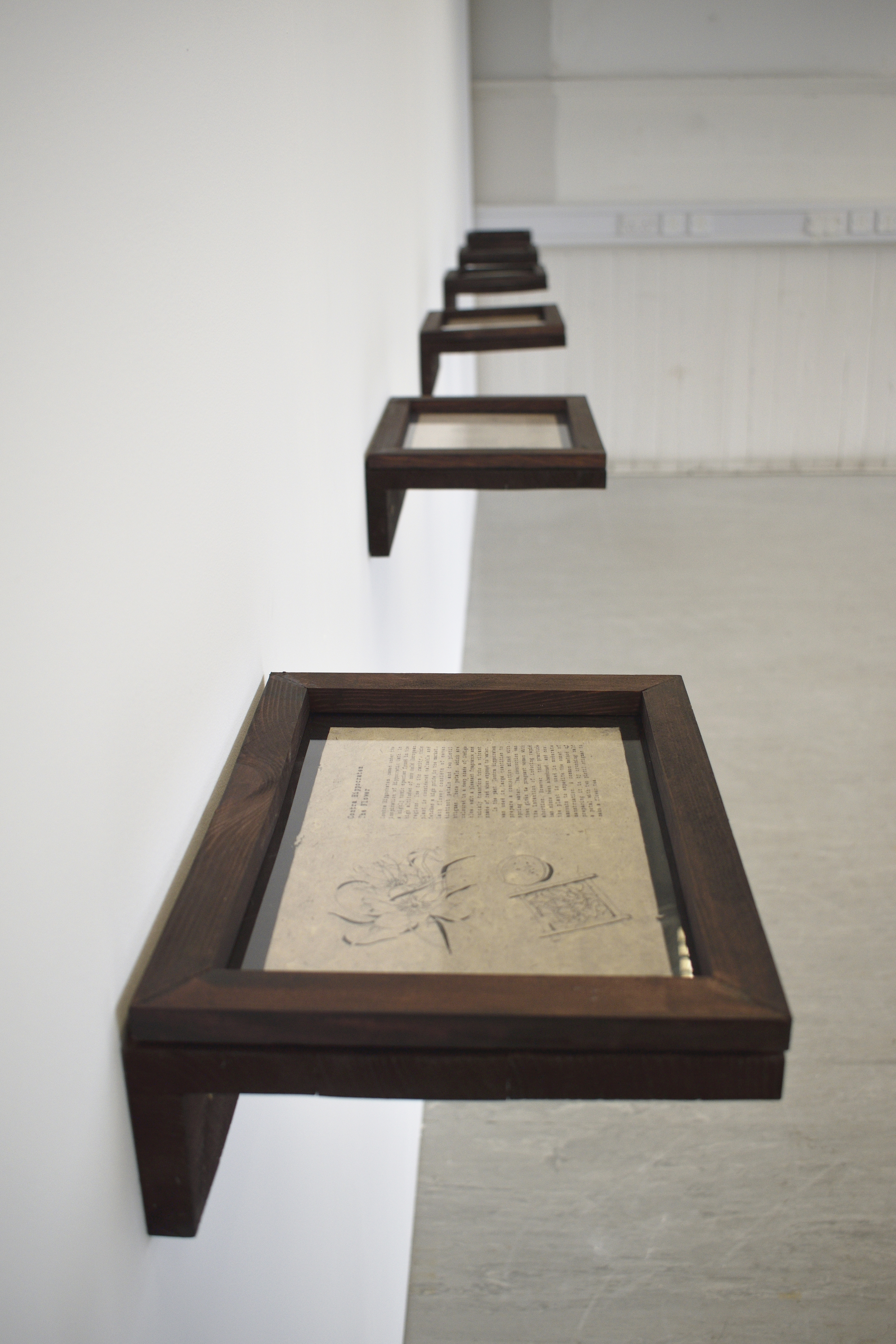Wenyi Pan
“April”
 Variable Size
Variable Size1/2023-6/2023
·Documentary [duration 08:51]: monitor, speakers, stools.
·Discoveries: concrete, copper, cloth, water-based printing medium, acrylic paint, MDF, Indian ink, PVA glue.
·Archives: rice paper, cotton paper, printing paper, water-based printing medium, acrylic paint, PVC, cloth, wood, wood stain, Danish oil.
April is a space - a continuous and an overlapping one. It consists of a film, fictional archival texts, and sculptures that mimic relics. The space is divided into three parts regarding the different components (fig.1): ‘Documentary’, ‘Archives’, and ‘Discoveries’, which are interconnected to each other. April can be seen as a museum’s thematic gallery, where rumours, objects and stories that represent women’s anxiety on menstruation are stored. In a pedagogical and archaeological way, it leads the viewer to reflect on the complex relationship between official knowledge, false knowledge, and individual experience on female bodies.
Documentary

 In ‘Documentary’, I filmed a young woman’s toilet trash bin from the same angle, making it a 30-day record of her experience in the toilet. I also recorded her monologues and dialogues with her family, partner, and friends. The story revolves around her menstruation anxiety and her mental state as items pile up in garbage bags. The girl’s actions and words in the story are closely related to the sculptures and texts in the space.
In ‘Documentary’, I filmed a young woman’s toilet trash bin from the same angle, making it a 30-day record of her experience in the toilet. I also recorded her monologues and dialogues with her family, partner, and friends. The story revolves around her menstruation anxiety and her mental state as items pile up in garbage bags. The girl’s actions and words in the story are closely related to the sculptures and texts in the space. Link for viewing : https://vimeo.com/842548976
Discoveries



 ‘Discoveries’ consists of six small cement sculptures on the plinths and one on the ground. The sculptures are made from real objects that can be found in garbage bags in the film. They were made to bear the feature of historical discoveries, which are arranged to pause the time and restage the memory inside the story of this film. (This is embodied in the seemingly meaningless exhibition stickers affixed to the plinths). Objects include the paper roll, hair, shampoo bottle, toothpaste, sanitary pads, pregnancy test stick, and the whole trash bag.
‘Discoveries’ consists of six small cement sculptures on the plinths and one on the ground. The sculptures are made from real objects that can be found in garbage bags in the film. They were made to bear the feature of historical discoveries, which are arranged to pause the time and restage the memory inside the story of this film. (This is embodied in the seemingly meaningless exhibition stickers affixed to the plinths). Objects include the paper roll, hair, shampoo bottle, toothpaste, sanitary pads, pregnancy test stick, and the whole trash bag. Archives


 ‘Archives’ consists of six book pages. I made up three books related to menstruation and selected six pages to put in wooden holders. They are the exaggerated and modified versions of the rumours and urban legends I collected in reality. The books are called “An Instruction for Menstruation”, “Hazards of Menstrual Products”, and “The Recurrence of Old Rituals in Modern Times” respectively. The years of publication become clues to their non-existence (18g8, 197b,20I3).
‘Archives’ consists of six book pages. I made up three books related to menstruation and selected six pages to put in wooden holders. They are the exaggerated and modified versions of the rumours and urban legends I collected in reality. The books are called “An Instruction for Menstruation”, “Hazards of Menstrual Products”, and “The Recurrence of Old Rituals in Modern Times” respectively. The years of publication become clues to their non-existence (18g8, 197b,20I3).Official knowledge and personal experience closely related to the body are not in opposition, nor in perfect harmony. The fear experienced by the body can often be alleviated by unrealistic talk, while familiar knowledge cannot help. That is why things that seem hilarious are believed, and why simple common sense is ignored. Such is the case with these stories about menstruation - they don’t need to be modified or criticized, they need to be recognised and accepted. April naturally manifests itself in the viewer’s consciousness and hints at the evidence of female unconscious dilemma. The performance of this museum scene serves as mild stinging pain and and helps people find neglected traumas in the conflict between laughing about what they just saw and realising what they always did.